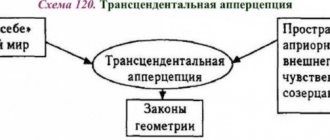Interiorization in psychology is the process of formation of the human psyche as a result of the consistent assimilation of external activities and social experience, with the subsequent development and transformation of one’s own nervous system.
The term “interiorization” itself was first voiced by the processor Durkheim, came from the French sociological school and in its original form was closely associated with socialization.
Thanks to the works of I.S. Vygotsky’s theory of transformation of external activity received a fundamentally new meaning, and thanks to the research of P.Ya. Halperin was transformed into a number of separate stages leading to a direct transformation of the highest functions of the human psyche.
During internalization, under the influence of external social activity, the formation and development of a stable internal psychological structure of the individual occurs, during which:
- human thinking appears and then expands;
- the child’s psyche grows and develops (from the moment of birth until he fully matures as a person);
- the individual’s life experience is formed;
- the child enters the social environment.
Definition
Interiorization in psychology is the gradual formation of a small person’s own psychological functions, which occurs through external influence and knowledge of the world, with the subsequent acquisition of one’s own life experience, which is responsible for the maturation of the individual.
Translated from Latin, “interior” (internal) denotes the transition from external to internal, as well as the transformation of external influence (activity) into internal mental operations.
The processing of external information shapes the individual’s experience, allowing subsequent mental activity to be carried out without the participation of objects.
According to psychologists who have studied the concept, any functions of the psyche first develop outside the human body, and then, with the help of interiorization, are “implanted” into human consciousness.
In the process of transferring the external to the inside, speech also develops, going through 3 stages in its development:
- vocal influence on the child from outside;
- adoption of skills and the baby’s own attempts to reproduce speech;
- the child’s ability to influence himself with words independently
In pedagogy
Pedagogy defines “interiorization” as the gradual formation in a child of the ability to handle symbols. Under external influence (parents and teachers), the child begins to learn to handle symbols, and then gradually transforms the acquired skills into his own symbolic process.
Interiorization in pedagogy is an important stage in the development of a student’s personality, during which not only knowledge is acquired, but also a person’s personal characteristics are transformed. The success of pedagogical internalization largely depends on the abilities of the teachers themselves, which affects not only the upbringing of the child, but also helps by transferring external data:
- develop a personality with an optimally integrated internal dynamic structure;
- create a stable motivational basis;
- learn the norms of morality and ethics accepted in human society.
In philosophy
Philosophy considers “interiorization” a practical possibility of knowing the world and being. According to D.V. Pivovarov, knowledge of a subject is the combination of theoretical knowledge about it with practical activity, which is the only opportunity to comprehend existence.
In sociology
Interiorization of personality occurs in society, which is responsible for the formation of a person, the assimilation of norms, rules of behavior and cultural heritage. Society allows the individual to develop, and the process of internalization helps a person adapt among the people around him.
According to Vygodsky, the social internalization of a person takes place in 3 stages:
- individualization, during which the child gradually assimilates accepted norms and repeats actions;
- intimateization, accompanied by the baby’s awareness of his own “I”;
- crystallization of the personality, on which exteriorization occurs, accompanied by the return by a person of previously processed skills and knowledge.
Internalization is in psychology
In psychology, interiorization is the transformation of the structure of objective activity into the internal structure of the personality. Transformation of interpsychological relations into intrapsychological ones. That is, interpersonal relationships turn into relationships between oneself and oneself.
The concept of interiorization was also used by P. Galperin in the formation of mental actions.
Interiorization in psychology is the process of understanding the internal nature of the determining action as a derivative of practical activity.
With internalization, activity changes greatly, especially its operational part.
Social interiorization is expressed in the process of communication, when mental processes are modified under its influence, since communication in a “latent” form is contained in these processes. The structure of mental functions is similar to the process of communication. This happens because the formation of mental functions occurs in early ontogenesis during the internalization of the communication process.
In the process of interiorization, deep, stable and synchronic structures are formed in the human psyche. These are a kind of social mechanisms that determine the nature of the “overlying” mental processes (emotional, cognitive). Therefore, it turns out that interiorization is a social mechanism of the psyche.
Interiorization and perception of personality, the transition to the internal plane of humanistic values, the formation of one’s own value orientation is impossible to implement only on a conscious level. Emotions play an active role in this process. The emotional side of this process has been studied and confirmed by numerous studies, which express that social values can be perceived not only by consciousness, intellectual thinking, but also by feelings and emotionality. Even if we take the understanding of social significance, it is not simply accompanied, but rather colored by sensuality. The involvement of the senses may determine the reality of the acceptance of such a meaning by the individual himself, and not by its understanding in general. Thus, in the process of internalization of universal human values, it is necessary to take into account the dialectical unity of the social and individual, cognitive and sensory, intellectual and emotional, rational and practical. Such integrity indicates a fairly high level of development of the value orientation of the individual. This, in turn, allows you to selectively relate to phenomena, surrounding objects, events, adequately perceive and evaluate them, establish both subjective and objective value, and navigate equally in spiritual and material culture.
Interiorization equally, without a predominant relation to any mental process (memory, perception), determines the social forms of all processes.
Interiorization has results related to the perception of sociocultural information (they manifest themselves especially clearly); everything that is perceived by a person (in the broad and narrow sense of this concept) is accepted in social forms. As a result, a number of persistent social mental structures are formed that shape consciousness. Also, the result is the formation on the basis of consciously determined, detailed, internal actions.
Behind the results of internalization, a peculiarity of the structures of mental processes is observed, which differs from the structure of the same processes in animals. The prerequisite for the process of internalization is an unconscious internal plan, which changes qualitatively in the process, since the plane of consciousness is formed. On the one hand, interiorization occurs in the process of communication, on the other hand, it occurs during the transfer of action from the external plane to the internal, mental plane.
This process is closely related to communication. During the gradual formation of mental actions within the framework of communication between those who form and those who are formed, interiorization has an important place in this formation.
Interiorized signs are acquired exclusively in the process of communication. But ontogeny still determines the structure, and this structure reflects their origin. A situation that has an interiorizing structure is communication, and its structure has within it a collapsed communication called dialogism.
Dialogue, which is a hidden mechanism of mental functions, is of great importance. Hidden dialogue or communication is considered as components in the deep internalized structure of the psyche. The function of signification carries within it a relationship of the subject-subject type, that is, it has a dialogical structure.
Interiorization is associated with exteriorization, the opposite concept to it. Exteriorization comes from the French “exteriorisation”, which means manifestation, and the Latin “exterior”, which means external, external. Exteriorization is a process in which internal mental actions transform into external, detailed object-sensory actions.
Internalization and exteriorization play an important role in developmental psychology. In order to develop a certain mental action in a child, for example addition, it must first be shown to the child as an external action, that is, it must be exteriorized. It is already in such an exteriorized, expanded form of external action that it is formed. Only then, in the process of its gradual transformation, a generalization of a specific reduction of links is created, a change in the levels at which it is performed, its interiorization is carried out, that is, its transformation into an internal action, which already takes place completely in the child’s mind.
Interiorization and exteriorization in psychology, in the activity approach, are the mechanisms by which socio-historical experience is acquired. Based on the study of this experience, the idea was born about the origin of the internalization of mental processes, the activity of human consciousness from external practical activity. Any type of human activity (educational, labor, play) is associated with the use of tools, instruments, means of labor, and with the creation of socially important products. Social experience cannot be conveyed without expressing it in external form, through speech, demonstration. With the help of this, a person is capable of perceiving and transferring the experience of generations. This process is not an ordinary movement, a copying of external activities into the internal plane of a person. This is the formation of consciousness, shared knowledge, common with the consciousness of other people, separate from them, perceived by a person and others in the same understanding.
The process of internalization arises from the fact that higher mental functions begin to develop as external forms of activity, and already in the process of internalization these functions are transformed into mental processes.
The fundamental principles of the internalization process can be described in several postulates. The structure of mental functions is revealed only in the process of genesis, when they have already formed, the structure becomes indistinguishable and goes deeper. The formation of mental processes reveals the true essence of a phenomenon that initially did not exist, but in the process of internalization it was created and began to develop. The essence of a phenomenon that has begun to manifest itself cannot be explained through physiological processes or logical schemes, but is capable of manifesting itself as a continuous process, even after the cessation of the influence of some phenomenon, and this process does not stop. Through internalization, the transformation of external signs into an internal plan of activity begins to occur. This process does not occur in isolation and independently. Normal mental development is possible in the presence of communication with loved ones. Thanks to internalization, a person learns to build mental plans and develop options for solving situations. Thus, the person acquires the ability to think in abstract categories.
Kinds
Internalization in psychology is a process closely related to socialization, classified depending on the stage of child development:
| Initial interiorization | Occurs in newborns and young children. During his development, the baby explores the outside world with the help of his parents, who consistently force him to carry out some actions, show him toys and introduce him to the world around him. |
| School interiorization | Closely related to the mental process on which all human learning is based. Studying school subjects requires an older child to perform actions not only on paper, but also in his mind. The development of this type directly depends on the motivation, skills, type of temperament and abilities of the child’s internal system. |
| Social interiorization | It begins from the very birth of a person and is associated with the interaction of the baby with the people around him. Divided into 3 circles of communication:
|
In the process of internalization, the child adopts not only experience, but moral norms accepted in society, the way of thinking and interests of his loved ones (especially parents), and then tries to copy the behavior observed in the process of cognition.
The process of development of psychological functions is also influenced by:
- cultural and religious traditions accepted in society;
- the language of communication;
- National cuisine;
- heroic figures revered in society.
The success of a future person in society largely depends on his compliance with the ideals accepted in society, or more precisely on the ability to correctly copy the behavior of the “heroes” of public consciousness. At different times, pilots, astronauts, doctors, bandits, and movie characters could be considered such people.
School adaptation
School learning is based on mental activity. Studying subjects such as physics, mathematics, history, chemistry, etc. at school assumes that the student will be given certain requirements, one of which is the ability to perform actions not only on objects and paper, but also in the mind, with great speed, or better yet automatically. The mechanism of personality internalization will also depend on the type of nervous system (some people grasp everything on the fly, while for others this process proceeds at a very slow pace), the type of temperament, and motivation. And here the division of children into those who are mastering the school curriculum and those who are lagging behind is very clear. As can be seen from the stages of development of mental activity, motivation is an impulse to external action.
Lack of cognitive interest, which is the basis of school motivation, leads to poor mastery of school material and low academic performance. Not only the characteristics of the nervous system play an important role here, but also social adaptation - a measure of the individual’s entry into society.
Stages
Interiorization in psychology is the gradual development of a higher mental psychological process based on the knowledge of actions coming from outside, assimilating them and turning them into one’s own mental activity.
- At the first stage of internalization, adults (most often parents) encourage the child with words to perform some action, for example, to build a tower of cubes.
- During the second stage, the child independently pronounces the action previously heard from adults, and then begins to perform it.
- At the third stage, previously stated tasks are transformed into a mental incentive process that forces a person to independently perform the necessary and correct actions.
The process of internalization in a child can be illustrated using the example of collecting a multi-colored pyramid. First, the mother teaches the child how to fold the construction set, telling what color the circles are and in what order they need to be placed.
At the next stage, the baby himself takes the figure he needs and pronounces his actions. After a certain time, the child assembles the pyramid independently, without words, focusing only on the thought process.
Mechanisms of interiorization
In psychology, the internalization mechanism includes 6 stages:
- At the first (motivational) stage, the child’s interest in learning is awakened or an adult’s call arises, sounding like “Let’s learn to fold objects.”
- At the second, indicative stage, the child watches the actions of an adult, who adds up the cubes and pronounces his actions: “If we add 1 more cube to two cubes, we get 3 cubes.”
- The third, material, is that the child learns to repeat the actions of his parents on his own, for example, taking cubes and adding them.
- At the fourth, stage of external speech, the baby is already able to pronounce “If you add 1 to 2, you get 3” without performing any actions.
- At the fifth stage of inner speech, the child learns to pronounce the action inside himself without voicing it to others.
- At the sixth, mental action, there is a transition to rapid mental calculation, a cut in speech and mental action.
The functional features of the internalization process were developed by P.Ya. Galperin, also voicing the opinion that only complete, consistent mastery of the mechanism of cognition can lead to a fast and effective thought process.
Social interiorization
In Russian psychology, interiorization means the process of transforming interpersonal relationships into relationships with oneself. The acceptance, processing and storage of sign information “inside” the psyche, based on memory, does not belong to the phenomenon of social interiorization. In the development of higher nervous activity in humans, the following stages are distinguished:
- An adult influences a child with words, encouraging him to engage in one activity or another;
- The child learns a new type of address and begins to influence the adult with words;
- The child influences himself with words.
All people, without exception, go through stages of social internalization. The child is accustomed to mental activity without the use of specific objects.
In activity theory, internalization is the transfer of certain external actions to the internal, mental plane. As a result of internalization, external activities undergo some changes, especially in the operational part.
Psychoanalysis explains the processes of influence of inter-individual relationships, the formation of the structure of the unconscious: individual and collective, which determines the structure of consciousness.
Theories of internalization
The term “interiorization” was first voiced by the French psychologist E. Durkheim, who presented it as an integral element of human consciousness, or more precisely as the relationship between the public (external) and personal (internal) world of the human psyche.
The French sociologist's theory was based on the view that human consciousness is formed taking into account external social ideas.
According to Durkheim, as the child develops, he borrows concepts, views and categories from the world around him, which then form his own structure of thinking. Durkheim's point of view was subsequently supported by the French sociologists Piaget, Janet and Wallon.
P. Janet considered “interiorization” as a psychological principle. In his theory, the term “interiorization” is the grafting of the ideology of society into the biological mental human structure, or rather the transfer of the social way of thinking unchanged into the internal psyche of the individual.
J. Piaget assigned internalization a second role at the stage of development of the psyche. The French sociologist put logical thinking in first place, and considered the “transition” from the non-mental to the mental to be internal and did not sanctify it in any way.
Among Soviet scientists, the greatest contribution to the theory of internalization was made by L.S. Vygodsky, who created the theory of the formation of the human psyche under the influence of external factors. The process of accepting the mechanism of relationships and the structure of society, according to the scientist, is transformed into the internal precisely in the process of interiorization, which is the basis for the development of psychological thinking.
Vygodsky’s theory was reflected in the psycho-pedagogical concept of A.P. Leontyev, who believed that the process of building a child’s mental activity is based on the original internal objective form, transforming, generalizing and accompanying speech, which it gradually turns into mental activity.
Vygodsky’s research and theory will be continued by P.A. Halperin, in the process of his own study of the transfer of impressions received from the outside world into the inner (own) world of a person. According to the scientist, during internalization, which is directly related to learning, the external activities of society are transformed into components of the psyche.
Meaningful human actions are carried out only after interaction with the outside world, since it is interiorization that is the mechanism that carries out the transition “inside” “from the outside” and ends with the process of forming mental activity.
In his works, Galperin described the mechanisms and stages of the development of mental activity, and also gave concepts such as the degree of formation of skills, the measure of communication and the level of performance.
Personality formation according to P. Ya. Galperin
Work in this direction was continued by the Soviet scientist P. Ya. Galperin. His merit lies in the fact that he continued the line of study of this phenomenon set by L. S. Vygotsky, which differed from the opinion of foreign scientists. J. Piaget assigned interiorization a secondary importance in the formation of the psyche up to a certain age; logical thinking was in the foreground. The transition from non-mental to mental (i.e., as a material action) becomes an internal process and is not illuminated.
On the contrary, L. S. Vygotsky and then P. Ya. Galperin insist that internalization is the key mechanism for transferring external impressions to the internal plane at all stages of development. The issue of the transition of the non-psychic plane to the mental plane is studied in depth.
Interiorization and communication
Communication plays a special role in internalization. It is this that shapes consciousness, absorbing the authorities and values accepted in society.
At the first stage of life, the main and main authority for a child is his parents. The baby perceives the words and actions of loved ones as an indisputable truth and tries to imitate as much as possible the rules of behavior accepted in the family.
Growing up, a child expands his social circle, forcing his consciousness to contrast the priorities of society and family values, and then, focusing on his inner conviction, choose his own path. In most cases, mature children prefer to remain in their familiar environment, having absorbed the way of thinking, rules of behavior and authorities represented by their parents.
Tactile contact is no less important for interiorization.
Research has shown that children left without parental care and forced to live in a medical institution until the age of 3, where communication standards were limited only to the necessary medical framework, although they understood their native speech, and also had a small set of words, they preferred to communicate in their own language. own language, and also had problems with hygiene skills.
Most orphans did not know how to brush their teeth, use a spoon or dress themselves. During communication with teachers and children living in the orphanage, the psychological state of the children gradually leveled out.
Interiorization and experience
Of great importance in the transformation of personality and the process of internalization is experience, which helps to choose a system of values, determine the worldview and image of a person’s relationship with the world around him.
It is impossible to pass on the experience of past generations to a child. It is possible to teach a child mastery, accumulated knowledge or skills with the secrets, but each person gains experience independently.
Going through difficult life situations, each person draws his own conclusions, which does not make it possible to assimilate the knowledge of the previous generation and avoid new mistakes. Experience previously acquired by parents or other members of society can help predict the development of the situation, but does not make it possible to avoid it.
Psychologists note that overcoming difficult life obstacles helps to strengthen and strengthen a person’s internal qualities, since by transforming previously gained experience in the process of interiorization, a person gains not only knowledge, but also improves his psychological state.
The relationship between interiorization and exteriorization
Interiorization and exteriorization are interconnected processes, mechanisms through which the process of assimilation of social experience occurs by a person. A person accumulates the social experience of generations through demonstration of tools and speech. This is interiorization, an active internal process of forming consciousness on the basis of learned experience.
Based on the acquired signs and symbols of society, a person forms his actions. This is the reverse process. The existence of one of them is impossible without the previous one. The concept of “exteriorization” thus means the formation of a person’s behavior and speech on the basis of the social experience internally formed in him into a certain pattern.
Application of interiorization
Interiorization in psychology is the gradual “implantation” of actions, skills, knowledge, cultural values and traditions of experience into a person’s own “inner” world, allowing a newborn child to gradually form his own mental activity and normalize living in the surrounding society.
Interiorization is applied:
- In the educational process, during which the teacher helps the child learn to carry out various mental actions.
- In a social environment, allowing children to gradually learn the rules of behavior accepted in society.
- In work relationships, between mentors and trainees or superiors and subordinates, giving the opportunity for a new employee to learn the skills and secrets of craftsmanship developed by experienced specialists.
For each child, the internalization process is built according to an individual program, taking into account the particular development and temperament of the individual.
Forms of human activity in psychology
External human activity, according to the activity approach in psychology, is represented by visible human behavior: practical operations, speech. The internal form of activity is mental, invisible to other people. For a long time, the subject of study of psychology was only internal activity, because external activity was considered its derivative. Over time, researchers came to the conclusion that both forms of activity form a single whole, depend on each other, and are subject to the same laws (the presence of a driving need, motive and goal). And interiorization and exteriorization are mechanisms of interaction between these forms of human activity.
Study methods
The study of internalization is carried out through:
- a conversation that allows you to assess the internal integrity of the individual and the ability to transfer observations and actions received in the outside world and society into your inner world;
- monitoring the process of internalization of the child;
- experiments conducted in a natural environment, and allowing us to find out how quickly a person’s consciousness allows him to assimilate new experience;
- testing.
Problems
Problems of development and study of internalization are related:
- With deviations in the psychophysical plane associated with impairment of the child’s hearing, vision, speech, functioning of the musculoskeletal system, mental, emotional and intellectual development, making it difficult for the child to assimilate material coming from the environment.
- With the universal interconnection and conditionality of social phenomena that prevent a child from overcoming the stereotypes and traditions that have developed in society, and then choosing a new path for his learning and development.
- With the selection of objective methods of cognition.
Interiorization in psychology is the gradual formation of a little person’s personality through gradual adaptation of activities, comprehension of norms, rules and cultural traditions accepted in society.
Derived from the French “intériorisation” (inside), the term characterizes the ability of the child’s psyche to create its own mental activity, through the gradual absorption and transformation of knowledge and skills received from parents, teachers and society, and also allowing for the establishment of mental, speech, tactile and emotional processes.
The concept of “exteriorization”
Exteriorization is a process the result of which is the transition of a person’s internal (mental, invisible) activity into external, practical activity. This transition takes on a sign-symbolic form, which means the existence of this activity in society.
Representatives of Russian psychology (A. Leontiev, P. Galperin) were involved in the development of the concept, but the first designation was given to it by L. Vygotsky. In his cultural-historical theory, the psychologist expressed the opinion that the process of formation of the human psyche and the development of his personality occur through the assimilation of cultural signs of society.
In the modern understanding, exteriorization is the process of constructing and implementing a person’s external actions, including verbal expression, on the basis of his internal mental life: personal experience, plan of action, formed ideas and experienced feelings. An example of this could be the assimilation of educational influence by a child and its outward manifestation through moral actions and judgments.











